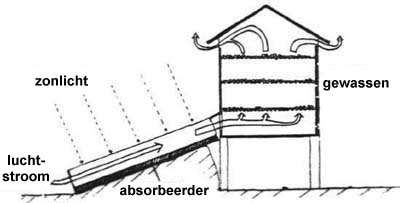A drying wire. You can laundry lay on the grass, but that provides little air circulation from below. Hanging is better to dry food. Use pens, (cloths)pins, pegs, hooks...
Hot stones and / or hot sand, possibly in a coffin, with grills.
An oven, which must be open for moisture- and air circulation. Not too hot, drying is not baking. The temperature is well between 30 and 70 degrees Celsius. From 75 degrees you are pasteurizing.
A fire. The heat is useful, and the smoke too. Smoke also keeps insects away and gives a special flavor.
Grills that you can stack above each other (over a fire). You can weave them of green twigs (which are flexible, pliable, tough).
If you often dry food and herbs it can be useful to make a dryer or drying tower:
a cabinet with a wide range of removable shelves from (insect) gauze,
of which you can open the roof more or less, in different positions.
 If you provide holes in the (possibly removable) bottom (s) you can heat the air with a warming source, so that it flows up through the cabinet. You can e.g. create a customized bottom for the heater, a radiator, candles...
If you provide holes in the (possibly removable) bottom (s) you can heat the air with a warming source, so that it flows up through the cabinet. You can e.g. create a customized bottom for the heater, a radiator, candles...
You can easily make a solar dryer. Install a window in a frame, with a black plate on the bottom. The air between the two plates (glass an black back) will warm up quickly in the sun, and rise. Provide inlet holes in the bottom of the boiler: plates, and discharge holes on top. They of course fit to the bottom of your (higher-level) drying tower. If you regularly orient the solar panel toward the sun you have a higher return.
Span mesh over all openings, then there may enter no bugs (or rodents,...).
With this you can dry a lot at once on a little surface and in a short period, and wind and insects cannot take your harvest.
Park your car in direct sunlight, put dry food on a platter on your dashboard (but preferably shielded from direct sunlight) ... Have you dried herbs (or other stuff) at the end of the day!
